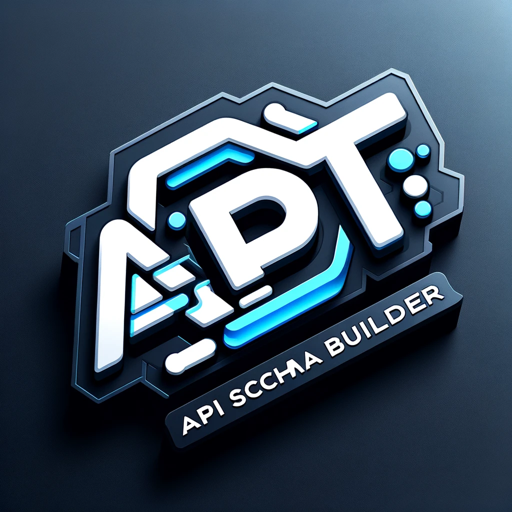API Builder 👉🏼 OpenAPI Schema-API design and documentation
AI-powered OpenAPI schema builder.
⚙️ Generate a full API for my GPT actions
🧩 What options do I have to build an API?
🔐 How can I add more security to my API?
⚡️ Write a full OpenAPI Schema for my API
Related Tools
Load More
OpenAPI Builder
Expert in converting APIs to OpenAPI Schemas, with a focus on education and best practices.

GPT Actions Builder
Converts websites to OpenAPI specs for ChatGPT Actions

GPT API Schema Builder
Create an API Spec For You Custom GPT. Instantly turn API docs into OpenAPI specs with our tool! Paste a cURL or a doc link, and get a perfect spec in a snap. It’s quick, easy, and error-free. Perfect for devs who want to save time and hassle.

Assistant API Builder
Agent specialist on building and deploying OpenAI Assistant API's

OpenAPI Schema Builder
Assists with OpenAPI Schemas by providing JSON Schema format examples, debugging tips, and best practices.

GPT Action Builder
Builds compliant OpenAPI schemas for custom GPT actions
20.0 / 5 (200 votes)
Introduction to API Builder 👉🏼 OpenAPI Schema
API Builder 👉🏼 OpenAPI Schema is a specialized tool designed to facilitate the creation, management, and integration of APIs using the OpenAPI Specification. It provides developers with a structured approach to define and document APIs, ensuring consistency, readability, and ease of use. The primary purpose of API Builder 👉🏼 OpenAPI Schema is to streamline the process of API development, making it easier for developers to create robust and scalable APIs that adhere to industry standards. Examples of its application include generating API documentation, creating mock servers for testing, and automating API validation.

Main Functions of API Builder 👉🏼 OpenAPI Schema
API Documentation Generation
Example
Using API Builder 👉🏼 OpenAPI Schema, developers can automatically generate comprehensive and interactive API documentation from OpenAPI definitions.
Scenario
A software development team needs to provide detailed API documentation to third-party developers. By leveraging the API documentation generation function, they can ensure that all endpoints, parameters, and responses are clearly documented and easy to understand.
Mock Server Creation
Example
API Builder 👉🏼 OpenAPI Schema allows developers to create mock servers based on API specifications, enabling them to test API endpoints without needing a live backend.
Scenario
During the development phase, frontend developers require a way to test their applications without a fully implemented backend. Using the mock server creation function, they can simulate API responses and continue their work seamlessly.
API Validation and Testing
Example
Developers can use API Builder 👉🏼 OpenAPI Schema to validate their API implementations against the OpenAPI specifications, ensuring compliance and correctness.
Scenario
Before deploying an API, a development team needs to verify that their implementation matches the defined specifications. By using the API validation and testing function, they can identify and correct any discrepancies, ensuring a reliable and accurate API.
Ideal Users of API Builder 👉🏼 OpenAPI Schema
Software Developers
Software developers benefit from API Builder 👉🏼 OpenAPI Schema as it provides tools to streamline the creation, documentation, and testing of APIs, making their workflow more efficient and reducing the likelihood of errors.
API Product Managers
API Product Managers use API Builder 👉🏼 OpenAPI Schema to ensure that APIs meet business requirements and standards. The tool helps them manage API lifecycles, maintain consistency across different API versions, and facilitate communication between development teams and stakeholders.

How to Use API Builder 👉🏼 OpenAPI Schema
Step 1
Visit aichatonline.org for a free trial without login, also no need for ChatGPT Plus.
Step 2
Familiarize yourself with the API Builder interface and available features by exploring the online documentation and tutorials.
Step 3
Identify your specific API requirements and use the schema builder to draft your OpenAPI specifications. Utilize the drag-and-drop interface to simplify the process.
Step 4
Validate your API specifications using the built-in validator to ensure compliance with OpenAPI standards.
Step 5
Generate the API documentation and export the OpenAPI schema for integration into your development workflow.
Try other advanced and practical GPTs
Coinography Content Engineer
AI-driven content generation for SEO success

Interpreter for Korean and English
AI-powered translations, perfected.

The Simulation
Experience Life's Journey with AI

KABUTO-23X-IT
Unleash the Power of AI with KABUTO-23X-IT

Ignition-AI
Empowering Industrial Automation with AI

プロンプトエンジニア
Enhance your prompts with AI precision
APUSH Tutor
AI-Powered Mastery for APUSH Students

YouTube Title Generator
AI-Powered YouTube Titles for Maximum Impact

CSS
AI-powered CSS Styling Tool

PowerShell
AI-powered PowerShell for Automation

Svelte
AI-powered Svelte framework.

Flask
AI-Powered Flask Development Made Easy

- API Design
- Integration Support
- Standards Compliance
- Schema Validation
- Documentation Generation
Q&A about API Builder 👉🏼 OpenAPI Schema
What is API Builder 👉🏼 OpenAPI Schema?
API Builder 👉🏼 OpenAPI Schema is a tool that simplifies the creation, validation, and documentation of APIs using the OpenAPI standard.
Do I need a subscription to use API Builder 👉🏼 OpenAPI Schema?
No, you can access a free trial at aichatonline.org without the need for a subscription or a ChatGPT Plus account.
Can I export the schemas created with API Builder?
Yes, API Builder allows you to export your OpenAPI schemas in various formats suitable for integration with your development tools.
Is there support available if I encounter issues?
Yes, comprehensive support is available through the online documentation, tutorials, and a dedicated support team reachable via the website.
What are the common use cases for API Builder 👉🏼 OpenAPI Schema?
Common use cases include designing new APIs, updating existing APIs, ensuring compliance with OpenAPI standards, and generating documentation for developers.